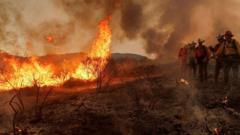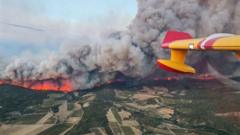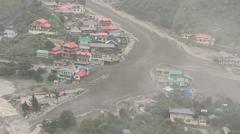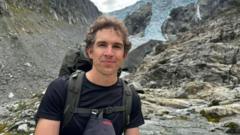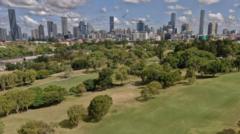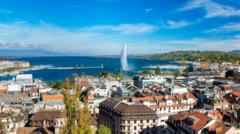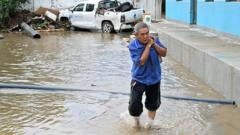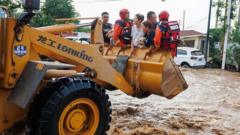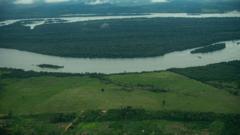As Swiss glaciers continue to melt, a small village named Blatten has been transformed into a disaster zone after a catastrophic landslide led to the evacuation of its residents. This incident has ignited a debate about the financial implications and moral responsibilities of rebuilding amid increasing climate threats.
Melting Ice, Shattered Lives: The Cost of Rebuilding Blatten, Switzerland
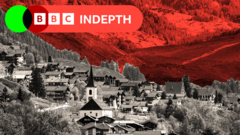
Melting Ice, Shattered Lives: The Cost of Rebuilding Blatten, Switzerland
The community of Blatten faces an uncertain future after a devastating landslide linked to climate change that erased their village from the map.
The picturesque Swiss village of Blatten once stood as a symbol of alpine charm, nestled in the serene landscape of the Loetschental valley. That tranquility was shattered just two months ago when a massive portion of the mountain and glacier surged down, engulfing the entire village—a site where around 300 residents called home. Mayor Matthias Bellwald, who describes the heartbreaking scene of devastation, has taken a temporary office in Wiler as he oversees a substantial clean-up and rebuilding operation.
Many who lived there, like Lukas Kalbermatten, experienced a profound sense of loss as their family-run hotel was obliterated. “The feeling of the village, the alleys, the church... all this is gone," he laments. Though aerial views display a site marked by debris, there is hope; Bellwald estimates a potential timeline for the reconstruction to see new houses by 2029. However, the financial burden of this rebuild is significant—potentially reaching an estimated $1 million per resident, totaling hundreds of millions of dollars.
This tragedy has stirred discussions about whether rebuilding such areas is a sustainable choice, especially as Switzerland spends nearly $500 million annually on protective measures against natural hazards. Yet, experts argue these efforts require a steep increase, potentially multiplying costs sixfold.
Amid this, residents face difficult truths about climate change. As they grapple with the statistical implications of rising global temperatures, glaciologist Matthias Huss highlights the stark reality that climate progression contributes directly to such disasters. The thaw rate of permafrost and instability in mountainous regions is alarming, reshaping the traditional Alpine identity.
In contrast, many locals prefer to cling to nostalgia over their homes, asserting that events like this are rare. However, scientists indicate that landslides in the Alps are becoming increasingly frequent and unpredictable. The case of Blatten is not isolated; nearby regions like Brienz and Kandersteg also face potential evacuations and instability.
The topic sparks heated debate about the viability of preserving these villages at great expense versus the painful choice to abandon them. Influential local publications challenge the economic model that supports remote communities, urging a broader conversation about preparedness and resilience in the face of impending climate fallout.
Cultural sentiments run deep, as many Swiss consider their "heimat"—a sense of home and identity tied closely to these villages. Kalbermatten expresses concerns about the loss of cultural heritage if these areas become depopulated, evoking parallel stories from northern Italy where entire villages were abandoned.
As recovery efforts push forward, the enduring spirit of the inhabitants shines through. Community members gather for daily updates on recovery, embracing resilience in the face of adversity. Military personnel and engineers collaborate tirelessly to clear the wreckage, keeping the hope alive for a brighter future amidst the ruins.
In these tumultuous times, the questions remain: What is the cost of preserving a way of life in the shadow of the Alps? And can the human spirit truly tame the forces of nature? The battle continues as both recovery efforts and discussions about the fate of vulnerable alpine villages unfold.
Many who lived there, like Lukas Kalbermatten, experienced a profound sense of loss as their family-run hotel was obliterated. “The feeling of the village, the alleys, the church... all this is gone," he laments. Though aerial views display a site marked by debris, there is hope; Bellwald estimates a potential timeline for the reconstruction to see new houses by 2029. However, the financial burden of this rebuild is significant—potentially reaching an estimated $1 million per resident, totaling hundreds of millions of dollars.
This tragedy has stirred discussions about whether rebuilding such areas is a sustainable choice, especially as Switzerland spends nearly $500 million annually on protective measures against natural hazards. Yet, experts argue these efforts require a steep increase, potentially multiplying costs sixfold.
Amid this, residents face difficult truths about climate change. As they grapple with the statistical implications of rising global temperatures, glaciologist Matthias Huss highlights the stark reality that climate progression contributes directly to such disasters. The thaw rate of permafrost and instability in mountainous regions is alarming, reshaping the traditional Alpine identity.
In contrast, many locals prefer to cling to nostalgia over their homes, asserting that events like this are rare. However, scientists indicate that landslides in the Alps are becoming increasingly frequent and unpredictable. The case of Blatten is not isolated; nearby regions like Brienz and Kandersteg also face potential evacuations and instability.
The topic sparks heated debate about the viability of preserving these villages at great expense versus the painful choice to abandon them. Influential local publications challenge the economic model that supports remote communities, urging a broader conversation about preparedness and resilience in the face of impending climate fallout.
Cultural sentiments run deep, as many Swiss consider their "heimat"—a sense of home and identity tied closely to these villages. Kalbermatten expresses concerns about the loss of cultural heritage if these areas become depopulated, evoking parallel stories from northern Italy where entire villages were abandoned.
As recovery efforts push forward, the enduring spirit of the inhabitants shines through. Community members gather for daily updates on recovery, embracing resilience in the face of adversity. Military personnel and engineers collaborate tirelessly to clear the wreckage, keeping the hope alive for a brighter future amidst the ruins.
In these tumultuous times, the questions remain: What is the cost of preserving a way of life in the shadow of the Alps? And can the human spirit truly tame the forces of nature? The battle continues as both recovery efforts and discussions about the fate of vulnerable alpine villages unfold.


